Canada is a beautiful country with some of the nicest places in the world. If you’re heading to Canada, planning on moving there, or just want to impress your friends with Canada’s provinces and territories information, this article will help to know about.
Here you’ll find knowledge about all states of Canada, including every province and territory best places and tourist destinations.
Canada is a country in the northern part of North America, located between the United States and all of the Pacific Ocean. Canada is divided into four main parts called Provinces and Territories.
The regions of Canada are:
- Western Canada
- Central Canada
- Atlantic Canada
- Northern Canada
Under these regions, there are 10 provinces and 3 territories in Canada these details are given below. So we are starting step by step;
What is the position of Canada on the world map?

Canada is the second biggest country in the world by land area, after Russia. It is bounded by the United States to the south and the U.S. state of Alaska to the northwest; also, Saint-Pierre and Miquelon, in France, Greenland, Bermuda, and the Caribbean Sea (with which Canada has a territorial dispute over some of its islands) to the North and northeast.
Canada’s land borders are with the United States to the south, and with the British realm of Nunavut – one of only two territories sharing a land border with Canada – to the east.
There are so many things to do and see in Canada that you might need a second trip back to visit the rest of the country. Below is a Canada map with states name and border, hopefully this Canada states map will help you to navigate all areas of the provinces and territories in Canada. So you can plan your next trip with ease!
Canada States Map With Borders
Here is the Canada map with states that border Canada:
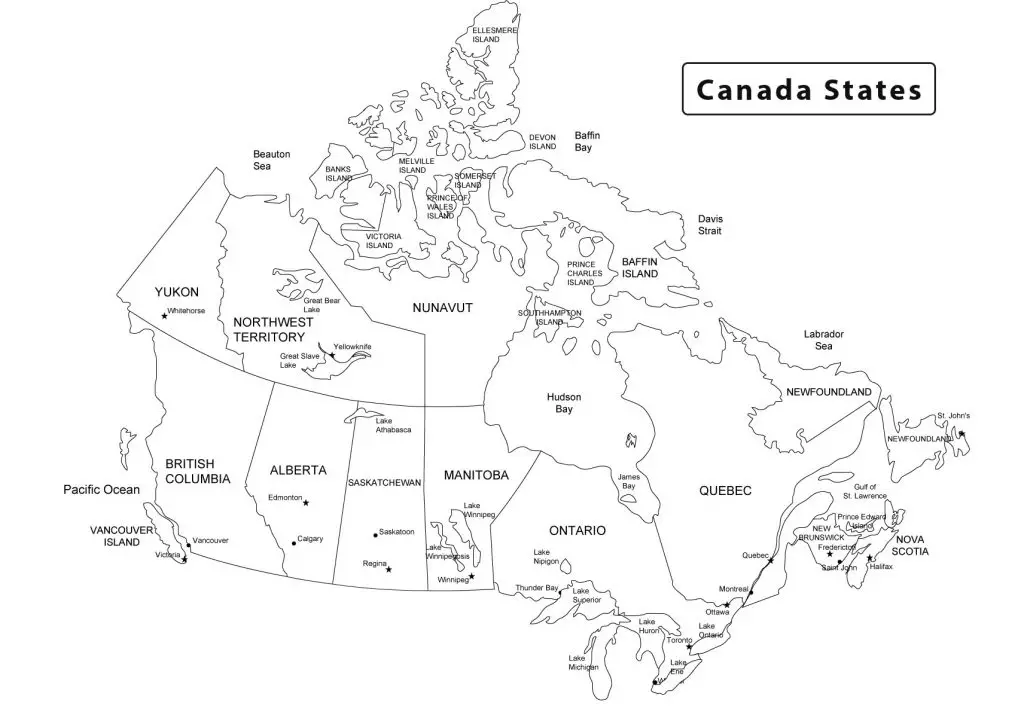
How many provinces are in Canada?
In Canada, there are ten provinces. The names and capitals of the provinces are: British Columbia, Victoria; Alberta, Edmonton; Saskatchewan, Regina; Manitoba, Winnipeg; Ontario, Toronto; Quebec, Quebec City; New Brunswick, Fredericton; Nova Scotia, Halifax and Prince Edward Island. These provinces have their own provincial governments.
What is the list of states in Canada?
The Canadian provinces in alphabetical order:
- Alberta
- British Columbia
- Manitoba
- New Brunswick
- Newfoundland and Labrador
- Nova Scotia
- Ontario
- Prince Edward Island
- Quebec
- Saskatchewan
The four most populous provinces are Ontario, British Columbia, Quebec, and Alberta, but within these places, there are also a number of provincial capitals that are very different from each other. We’re going to help you navigate Canada’s numerical maze by providing you with information about each province, territory, and its major cities.
There are also three territories located in Canada. These are Northwest Territories, Yukon, and Nunavut.
The difference between territories and provinces lies in how the power and authority are delegated. The governmental power and authority of provinces come from the Constitution Act of 1867. Governmental powers of territories are designated through the Parliament of Canada.
Each province is considered to be sovereign and has its own representative of the Canadian monarchy. These representatives are known as lieutenant governors. Territories, on the other hand, are not sovereign and have a commissioner. These territories also receive all authority and responsibility from the federal government.
The nation of Canada isn’t divided into states like the United States. It is divided into sub-national governmental areas known as provinces and territories.
Maybe you are looking for more information about the Canadian provinces and territories.
The following is a list of Canada’s provinces and territories, ranked in order of the Confederation Entered.
List of Provinces and Territories Canada
Canada is made up of the following ten provinces and three territories. Do you know all states of Canada’s confederation entered date? Do you know basic info about Canadian states and cities? If you don’t know about provinces and capital cities of Canada, then read on;
Now, we are going to share detailed information about the states of Canada with map.
NB: Canada states names are listed by confederation entered date.
Ontario
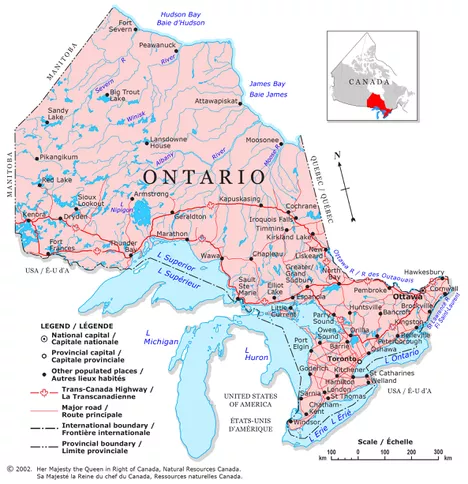
Capital: Toronto
Entered Confederation: July 1, 1867
Population: 14,826,276
Area: 415,598 square miles (1,076,395 sq km)
Ontario is the most populous province in Canada and its capital is Toronto, which is one of the biggest cities in Canada. You know, the CN Tower, Hockey Hall of Fame, and Niagara Falls are located in Ontario. It is a beautiful place.
Ontario is located in east-central Canada. It is Canada’s most populous province accounting for 38.3 percent of the population. The city itself has around 750k people and offers many different cultural festivals and events throughout the year.
It is also home to the federal capital of Ottawa and the unofficial financial capital of Toronto. The majority of Ontario state residents live in the southern part of the province near Toronto, along with Ottawa, Niagara Falls, and Niagara-on-the-Lake.
Ontario is best known for Algonquin Park, the Niagara wine region, Bruce Trail (the oldest and longest continuous public footpath in Canada), and the many beautiful forests and lakes. You can go to the observation.
Cities and towns in Ontario:
- Bancroft
- Barrie
- Belleville
- Brampton
- Brantford
- Brockville
- Burlington
- Cambridge
- Chatham
- Chatham-Kent
- Cornwall
- Elliot Lake
- Etobicoke
- Fort Erie
- Fort Frances
- Gananoque
- Guelph
- Hamilton
- Iroquois Falls
- Kapuskasing
- Kawartha Lakes
- Kenora
- Kingston
- Kirkland Lake
- Kitchener
- Laurentian Hills
- London
- Midland
- Mississauga
- Moose Factory
- Moosonee
- Niagara Falls
- Niagara-on-the-Lake
- North Bay
- North York
- Oakville
- Orillia
- Oshawa
- Ottawa
- Parry Sound
- Perth
- Peterborough
- Picton
- Port Colborne
- Saint Catharines
- Saint Thomas
- Sarnia-Clearwater
- Sault Sainte Marie
- Scarborough
- Simcoe
- Stratford
- Sudbury
- Temiskaming Shores
- Thorold
- Thunder Bay
- Timmins
- Toronto
- Trenton
- Waterloo
- Welland
- West Nipissing
- Windsor
- Woodstock
- York
Quebec
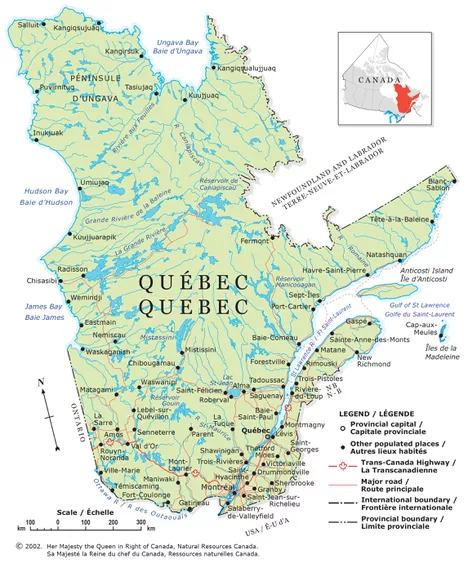
Capital: Quebec City
Entered Confederation: July 1, 1867
Population: 8,604,495
Area: 595,391 square miles (1,542,056 sq km)
Quebec is one of the provinces in Canada. It is located in the eastern part of Canada, with Labrador to its east, Newfoundland and Labrador to its northeast, New Brunswick to its west, Ontario to its northwest, and Hudson Bay to its south. Quebec has a total area of 1,542,056 square kilometers (595,365 sq mi), making it the second largest province in Canada by land area. It is also the largest province in terms of population and the most populous Canadian province.
For years, it has been ranked as one of the best places to live in the world, in large part due to its high quality of life and abundance of opportunities and resources.
Quebec is unique in that it is one of the few provinces where French is a co-official language. Visitors will often notice both spoken languages — English and French — being used at the same time. It was a British colony before it joined Canada in 1867 and gained provincial status in the Constitution Act of 1867.
Its capital is Québec City and its largest city is Montreal. Most residents live along and near the St. Lawrence River, especially in and between Montreal and Quebec City, the two major cities.
Cities and towns in Quebec:
- Asbestos
- Baie-Comeau
- Beloeil
- Cap-de-la-Madeleine
- Chambly
- Charlesbourg
- Châteauguay
- Chibougamau
- Côte-Saint-Luc
- Dorval
- Gaspé
- Gatineau
- Granby
- Havre-Saint-Pierre
- Hull
- Jonquière
- Kuujjuaq
- La Salle
- La Tuque
- Lachine
- Laval
- Lévis
- Longueuil
- Magog
- Matane
- Montreal
- Montréal-Nord
- Percé
- Port-Cartier
- Quebec
- Rimouski
- Rouyn-Noranda
- Saguenay
- Saint-Eustache
- Saint-Hubert
- Sainte-Anne-de-Beaupré
- Sainte-Foy
- Sainte-Thérèse
- Sept-Îles
- Sherbrooke
- Sorel-Tracy
- Trois-Rivières
- Val-d’Or
- Waskaganish
Nova Scotia
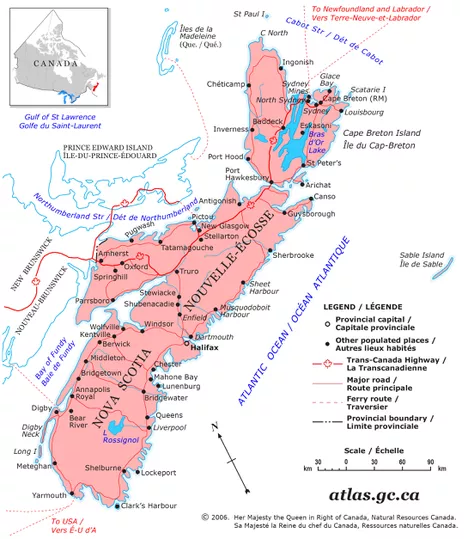
Capital: Halifax
Entered Confederation: July 1, 1867
Population: 992,055
Area: 21,345 square miles (55,284 sq km)
Nova Scotia is one of Canada’s three Maritime provinces and has a ton of great attractions for you to enjoy. There is plenty of history, beautiful scenery, great food, and tons of activities for you, your family, and friends to explore.
When planning a trip to Nova Scotia it might be best to break it up into two regions- south and north. The southern part of the province is home to the Bay of Fundy, which is full of picturesque waterfalls, unique wildlife, amazing seafood, and some interesting history as well.
A lot of people call it the nation’s coolest province and it is easy to see why every year, thousands of tourists visit the country. Like most other parts of Canada, Nova Scotia offers tons of activities and things to do.
Cities and towns in Nova Scotia:
- Baddeck
- Digby
- Glace Bay
- Halifax
- Liverpool
- Louisbourg
- Lunenburg
- Pictou
- Port Hawkesbury
- Springhill
- Sydney
- Yarmouth
New Brunswick
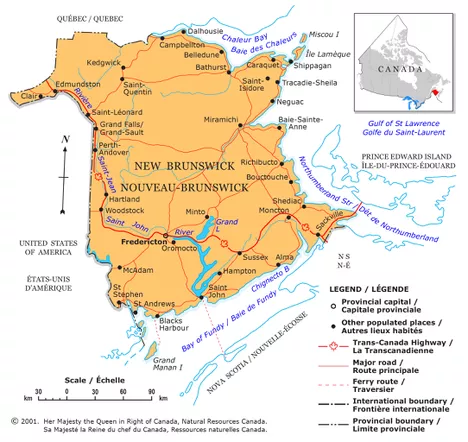
Capital: Fredericton
Entered Confederation: July 1, 1867
Population: 789,225
Area: 28,150 square miles (72,908 sq km)
New Brunswick is a Canadian maritime province on the eastern coast of Canada. It’s the only constitutionally bilingual province and has the highest population amongst New England states. The state of New Brunswick is also referred to as NB.
New Brunswick is the most western province of Canada and has an estimated population of 751,171. The capital is Fredericton and the largest city is Saint John.
It was named for the city of Braunschweig, Germany (also known as Brunswick or Wolfenbuttle). The province consists of the Saint John River Valley and the smaller river valleys of the Gloucester, Shepody, and Canapasquia rivers. It borders Quebec to the east, New England to the south, and Maine to the west.
Cities and towns in New Brunswick:
- Bathurst
- Caraquet
- Dalhousie
- Fredericton
- Miramichi
- Moncton
- Saint John
Manitoba
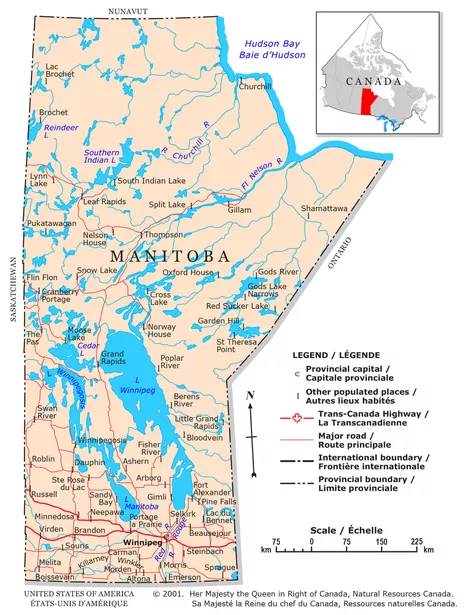
Capital: Winnipeg
Entered Confederation: July 15, 1870
Population: 1,383,765
Area: 250,115 square miles (647,797 sq km)
Manitoba, Canada is a beautiful province with a unique culture and soul. Manitoba offers urban cities as well as small towns and villages where you can enjoy yourself and have fun.
Manitoba is a Canadian prairie province bordering Saskatchewan to the west, Ontario to the east, Nunavut to the north, and the U.S. states of North Dakota and Minnesota to the south.
The capital city is Winnipeg and you’ll find the Red River flowing through its central area.
If you are searching on the web for the best places to live or moving to Canada, you can visit this place in Canada called Manitoba and discover why it is one of the best places to live in Canada.
Cities and towns in Manitoba:
- Brandon
- Churchill
- Dauphin
- Flin Flon
- Kildonan
- Saint Boniface
- Swan River
- Thompson
- Winnipeg
- York Factory
British Columbia

Capital: Victoria
Entered Confederation: July 20, 1871
Population: 5,214,805
Area: 364,764 square miles (944,735 sq km)
British Columbia is situated in the Western part of Canada. British Columbia joined the Canadian Confederation on July 20, 1871, although the vast majority of British Columbians previously considered themselves not just British subjects but also British citizens.
It is bordered by Alberta, the Yukon Territory and the Pacific Ocean to its west. Alberta lies to the east while the US state of Alaska separates British Columba from the US state of Washington across the Behring Strait.
British Columbia, Canada – B.C. for short is an amazing province to visit and an even better place to live and work. Beforehand it was a region set apart by mountains, forests and sea that had only limited contact with its nearest neighbors, the colonies to the east.
British Columbia is known for its stunning scenic beauty, especially in the winter. From Vancouver Island to the Canadian Rockies, there are plenty of things to see and do across this province.
This beautiful area of Canada is home to the majestic Rocky Mountains, the Pacific Ocean, Vancouver, Victoria, and many other stunning areas of interest.
British Columbia is a huge tourism attraction. Many tourists get to this beautiful location each year, and so many of these tourists are coming from other parts of Canada. With all the natural scenery this state has to offer, it makes it hard to believe that British Columbia was once covered by glaciers. This state has something for everyone, whether you love hiking the mountains or need a more laid back vacation.
Cities and towns in British Columbia:
- Barkerville
- Burnaby
- Campbell River
- Chilliwack
- Courtenay
- Cranbrook
- Dawson Creek
- Delta
- Esquimalt
- Fort Saint James
- Fort Saint John
- Hope
- Kamloops
- Kelowna
- Kimberley
- Kitimat
- Langley
- Nanaimo
- Nelson
- New Westminster
- North Vancouver
- Oak Bay
- Penticton
- Powell River
- Prince George
- Prince Rupert
- Quesnel
- Revelstoke
- Rossland
- Trail
- Vancouver
- Vernon
- Victoria
- West Vancouver
- White Rock
Prince Edward Island
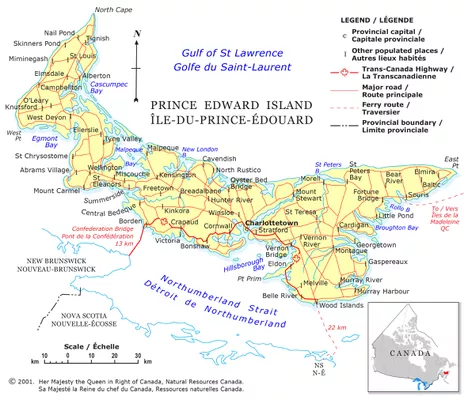
Capital: Charlottetown
Entered Confederation: July 1, 1873
Population: 164,318
Area: 2,185 square miles (5,660 sq km)
Prince Edward Island is one of the three Maritime beautiful provinces in Canada. It’s located on the east coast of Canada. This province has been a delightful vacation destination for tourists from all over North America and Europe. Prince Edward Island is also a wonderful place for vacation and living.
The island offers spectacular views of red sandstone cliffs dropping off into the ocean, nature reserves thick with trees and wildlife, and green rolling fields where you can find ancient red sandstone cliffs from which to enjoy the scenery. There are also several famously charming villages including Cavendish, home of Anne of Green Gables – a must-stop for any visitor to the island.
Cities and towns in Prince Edward Island:
- Cavendish
- Charlottetown
- Souris
- Summerside
Alberta
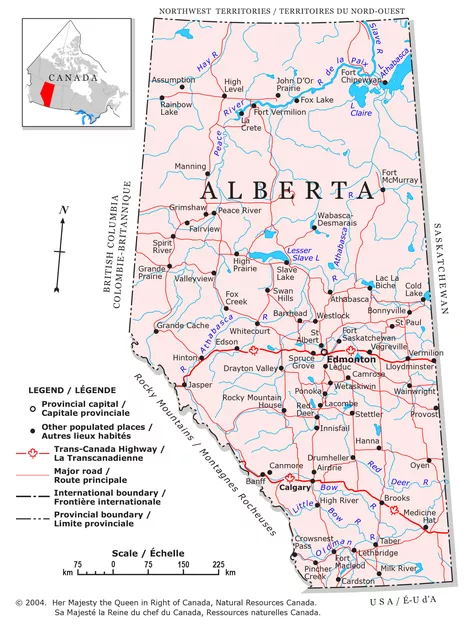
Capital: Edmonton
Entered Confederation: September 1, 1905
Population: 4,442,879
Area: 255,540 square miles (661,848 sq km)
Alberta is a province located on the western side of Canada. It borders the provinces of British Columbia, Saskatchewan, and the Northwest Territories.
Alberta is part of the western frontier, which includes a fertile farm area where food products are produced for export. The province’s abundant natural resources make it a thriving resource-based economy.
If you love the great outdoors, Alberta has plenty to offer including Banff National Park and Jasper National Park for hiking and camping.
The capital city of Alberta is Edmonton, which also accounts for one third of the province’s population.
Cities and towns in Alberta:
- Banff
- Brooks
- Calgary
- Edmonton
- Fort McMurray
- Grande Prairie
- Jasper
- Lake Louise
- Lethbridge
- Medicine Hat
- Red Deer
- Saint Albert
Saskatchewan
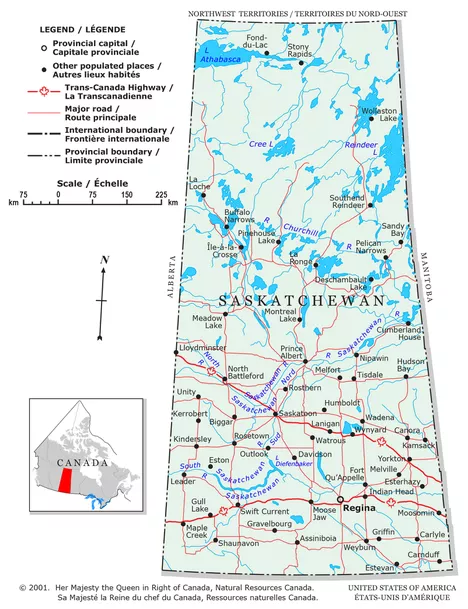
Capital: Regina
Entered Confederation: September 1, 1905
Population: 1,179,844
Area: 251,366 square miles (651,036 sq km)
Saskatchewan is a prairie province in Canada, Saskatchewan is the only prairie province with significant forest cover. Along with Alberta, Saskatchewan is one of only two landlocked provinces. The southern part of the province is bordered by Alberta, while the rest is bordered by Manitoba and the United States.
Regina is the province’s capital. Saskatchewan’s economy is based on agriculture, mining, and energy. The famous national parks and resorts in the province include Grasslands National Park, Prince Albert National Park, Waskesiu Wilderness Resort, etc.
The Prairie province of Saskatchewan is home to incredible people, breathtaking landscapes, and rich culture.
Cities and towns in Saskatchewan:
- Borden
- Batoche
- Cumberland House
- Estevan
- Flin Flon
- Moose Jaw
- Prince Albert
- Regina
- Saskatoon
- Uranium City
Newfoundland and Labrador
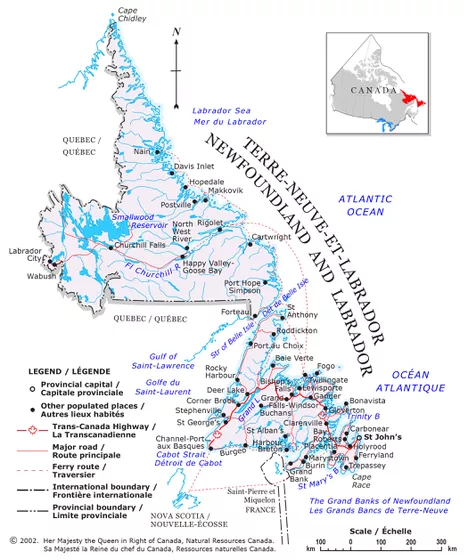
Capital: St. John’s
Entered Confederation: March 31, 1949
Population: 520,553
Area: 156,453 square miles (405,212 sq km)
Newfoundland and Labrador is the most easterly province in Canada. The provinces of Labrador and Newfoundland were both parts of the British Colony of Newfoundland, which joined the Confederation in 1949. It is the only province that is completely on the mainland of North America, and it shares maritime borders with Nova Scotia, New Brunswick, and Prince Edward Island.
Newfoundland and Labrador, or Labrador as it’s often referred to, is Canada’s most easterly province. At least one million people visit this corner of Canada every year, not just for its natural beauty but for its unique culture and arts scene. Whether you’re visiting on a day trip from Saint John or planning a long vacation in the region, here are some things you should know about Newfoundland and Labrador.
Cities and towns in Newfoundland and Labrador:
- Argentia
- Bonavista
- Channel-Port aux Basques
- Corner Brook
- Ferryland
- Gander
- Grand Falls–Windsor
- Happy Valley–Goose Bay
- Harbour Grace
- Labrador City
- Placentia
- Saint Anthony
- St. John’s
- Wabana
These are the Canadian Territories
Northwest Territories
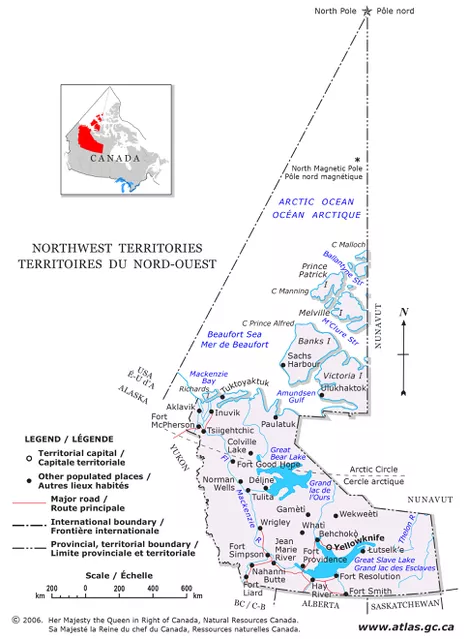
Population: 45,504
Capital: Yellowknife
Entered Confederation: July 15, 1870
Area: 519,734 square miles (1,346,106 sq km)
The Northwest Territories is a territory of Canada that lies mostly in the Arctic. The capital city of the Northwest Territories is Yellowknife, and the second largest is Inuvik. It borders the Canadian provinces of Alberta and Saskatchewan to the south and Nunavut to the east.
Northwest Territories, Canada – it’s where the greatest lakes on Earth by far meet North America’s longest river. Northwest Territories, Canada was also home to the world-famous Franklin Expedition, one of the most mysterious maritime disasters in history.
Cities and towns in Northwest Territories:
- Fort Smith
- Hay River
- Inuvik
- Tuktoyaktuk
- Yellowknife
Yukon
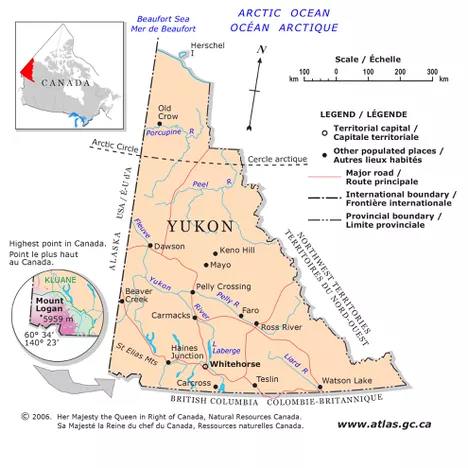
Population: 42,986
Capital: Whitehorse
Entered Confederation: June 13, 1898
Area: 186,272 square miles (482,443 sq km)
Yukon officially became a territory of Canada in 1898. Its capital is Whitehorse. It is the largest area/province or whatever you want to call it and has many meanings. It is also a place for fun and activities for everyone.
The Yukon Territory actually has two official languages, English and French (as well as First Nations languages). Most people who live there are from Canada and Europe, but there are also Asians there now.
Cities and towns in Yukon:
- Dawson
- Watson Lake
- Whitehorse
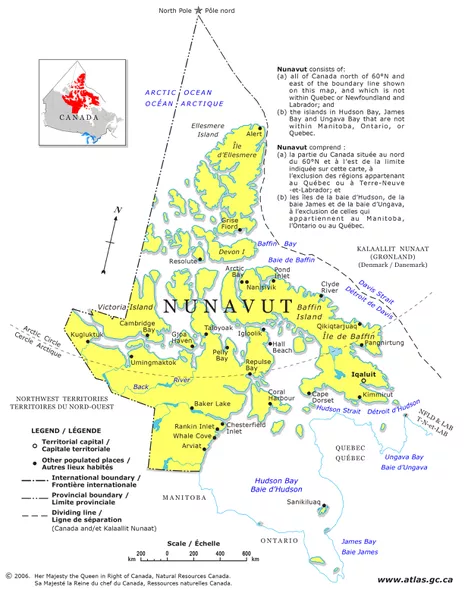
Population: 39,403
Capital: Iqaluit
Entered Confederation: April 1, 1999
Area: 808,185 square miles (2,093,190 sq km)
Nunavut is the largest and most northern territory of Canada. It is the newest territory as well, having been separated from Northwest Territories in 1999.
One of the world’s most remote locations, it has the second smallest population in Canada. The capital is Iqaluit and adventurers travel to the area to watch the narwhals, see the polar bears, and explore this remote territory.
The territory is known for its indigenous Inuit people’s artwork, carvings, and handmade traditional clothing. The art is displayed at the Nunatta Sunakkutaangit Museum in the capital.
List of Canada states by various orders
This is the list of Canada states arranged in various orders.
States in Canada by Population
If you have always wondered which are the biggest states in Canada by population, you’ll find this article interesting. We’ve tried to put together a few pieces of statistics:
| Canada states | Population |
| Ontario | 14,826,276 |
| Quebec | 8,604,495 |
| British Columbia | 5,214,805 |
| Alberta | 4,442,879 |
| Manitoba | 1,383,765 |
| Saskatchewan | 1,179,844 |
| Nova Scotia | 992,055 |
| New Brunswick | 789,225 |
| Newfoundland and Labrador | 520,553 |
| Prince Edward Island | 164,318 |
Canada states abbreviations
The abbreviated form of every state:
| Canada states | Abbreviation |
| Ontario | ON |
| Quebec | QC |
| British Columbia | BC |
| Alberta | AB |
| Manitoba | MB |
| Saskatchewan | SK |
| Nova Scotia | NS |
| New Brunswick | NB |
| Newfoundland and Labrador | NL |
| Prince Edward Island | PE |
If you are interested to know about Canadian Postal Code, may check out another article.
Final Words
Canada has achieved sovereignty over its mainland and is one of the world’s longest-standing constitutional monarchies. This country is sparsely populated with the majority of its landmass in forest or tundra, making it the world’s second largest country by total area.
If you want to travel and relocate to another city in Canada, you probably need this information. We have done our best to list all the states and territories in Canada.
Thanks!


